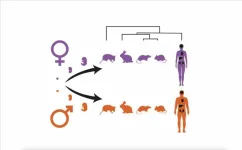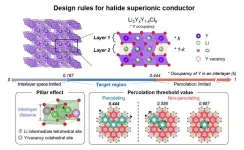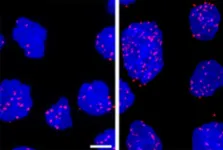(Press-News.org) The development of sex-specific characteristics is frequently seen in mammals. These characteristics stem from the activation of corresponding genetic programmes that until now have been largely undescribed by the scientific community. An international research team from the Center for Molecular Biology of Heidelberg University and The Francis Crick Institute in London has, for the first time, decoded the programmes that control the sex-specific development of major organs in selected mammals – humans, mice, rats, rabbits, and opossums. By comparing these programmes, the researchers were also able to trace the evolution of sex-specific organ characteristics.
Sexual dimorphism describes the development of secondary sex characteristics and in biology refers to the differences in the appearance of sexually mature males and females of the same species that are unrelated to the reproductive organs. Such sex-specific characteristics include clearly identifiable differences in the size and coloration of the body, or the development of different organs, such as antlers in male deer. In addition, there are less obvious differences in terms of the size, function, and cellular composition of internal organs. In humans, these differences, in the liver for example, can lead to sex-specific processing or efficacy of medications, according to Prof. Dr Henrik Kaessmann from the Center for Molecular Biology of Heidelberg University (ZMBH), who led the work together with Dr Margarida Cardoso-Moreira of The Francis Crick Institute in London.
The development of mammalian organs before and after birth is controlled by the finely tuned and complex interaction of many different genes – also known as gene expression programmes. “Overall, this development-related gene expression is fairly well understood, among other things through the work in our lab. Until now, however, what was largely unknown was how these programmes differ between female and male individuals and the effects these differences have on the function and cellular composition of organs in adult mammals,” explains Leticia Rodríguez-Montes, a doctoral candidate in Prof. Kaessmann’s “Evolution of the mammalian genome” research group.
The researchers in Heidelberg and London finally succeeded in systematically mapping the genes at the organ and cellular level that are primarily active in only one of the two sexes during development and therefore lead to the formation of different organ characteristics in female and male individuals. On the basis of sequencing data and by applying bioinformatic analysis methods, the researchers discovered a surprising pattern that applies to all the mammals they studied: “Almost all of the differences in gene expression abruptly develop only in puberty. That means that the genetic programmes responsible for the development of sex-specific organ characteristics are turned on almost exclusively late in the development of the organs, triggered by female or male hormones,” states Prof. Kaessmann.
To also understand the evolution of these gene regulatory programmes, the researchers compared their results for the various mammals in detail. “In most species we studied, the liver and kidneys exhibit numerous differences in gene expression between the sexes, which in turn lead to marked sex-specific differences in the functionality of these organs,” explains Dr Cardoso-Moreira. The researchers further learned that these differences between the sexes occur across mammals in the same organs and the same cell types in these organs; but they mostly occur through the activity of different genes.
The current findings illustrate the rapid evolution of sex-specific characteristics, which according to Leticia Rodríguez-Montes are probably due to different challenges during speciation. “One exception are the few genes found on X and Y sex chromosomes that presumably function as basic genetic triggers for the development of sex-specific characteristics in all mammals,” explains the researcher.
The results were published in the journal Science. The European Research Council funded the work. The research data are available in a public access database.
END
How organs of male and female mammals differ
Researchers from Heidelberg and London decode genetic programmes that underlie the development of sex-specific characteristics of mammalian organs
2023-11-02
ELSE PRESS RELEASES FROM THIS DATE:
New designs for solid-state electrolytes may soon revolutionize the battery industry
2023-11-02
Researchers led by Professor KANG Kisuk of the Center for Nanoparticle Research within the Institute for Basic Science (IBS), have announced a major breakthrough in the field of next-generation solid-state batteries. It is believed that their new findings will enable the creation of batteries based on a novel chloride-based solid electrolyte that exhibits exceptional ionic conductivity.
A pressing concern with current commercial batteries their reliance on liquid electrolytes, which leads to flammability ...
Black holes are messy eaters
2023-11-02
New observations down to light-year scale of the gas flows around a supermassive black hole have successfully detected dense gas inflows and shown that only a small portion (about 3 percent) of the gas flowing towards the black hole is eaten by the black hole. The remainder is ejected and recycled back into the host galaxy.
Not all of the matter which falls towards a black hole is absorbed, some of it is ejected as outflows. But the ratio of the matter that the black hole “eats,” and the amount “dropped” ...
New strategy attacks treatment-resistant lymphomas
2023-11-02
A surprising mechanism that makes some cancers treatment-resistant has been discovered by Weill Cornell Medicine and NewYork-Presbyterian investigators. The mechanism, which involves the shuttling of messenger RNAs (mRNAs) from the nucleus to the cytoplasm, ultimately facilitates DNA repair in cancer cells. These cancer cells can thereby thwart treatments aimed at damaging their DNA.
In a project encompassing both fundamental research and clinical studies they demonstrated that a combination of approved chemotherapies, ...
At least 14% of Americans have had long COVID
2023-11-02
One in seven people in the US reported having had long Covid by the end of 2022, suggests a large-scale investigation of long Covid and symptom prevalence by academics at UCL and Dartmouth.
Having had long Covid is associated with anxiety and low mood, as well as an increased likelihood of continued physical mobility problems and challenges with memory, concentration or understanding, according to the findings published in PLOS ONE.
The risk of anxiety and low mood appeared to be lower for those who have been vaccinated, ...
Mount Sinai researchers receive $7 million to improve outcomes for high-risk blood cancer patients from the Multiple Myeloma Research Foundation
2023-11-02
New York, NY (November 2nd, 2023) — The Mount Sinai Health System has received a $7 million grant from the Multiple Myeloma Research Foundation for a three-year project that aims to fast-track novel translational concepts to improve outcomes for people with high risk myeloma, the second most common blood cancer in the United States.
This grant award will facilitate a multidisciplinary research project that will analyze a large, diverse cohort of patient samples from all over the United States at the genomic and immune level and apply novel functional genomics technology to understand the critical events that drive ...
Pascal Lee awarded the 2023 Carl Sagan Prize for Science Popularization
2023-11-02
November 2, 2023, Mountain View, CA -- The SETI Institute is delighted to announce that Dr. Pascal Lee will be honored with the 2023 Carl Sagan Prize for Science Popularization presented by Wonderfest. The prestigious Sagan Prize recognizes and encourages individuals who “have contributed wonderfully to the public understanding and appreciation of science.” Previous recipients from the SETI Institute include SETI Institute co-founder and SETI pioneer Jill Tarter, senior astronomer Seth Shostak and trustee Andrew Fraknoi.
“I am truly delighted and humbled by this award,” says Pascal Lee, “all the more because Carl Sagan was, and remains, ...
UMBC team makes first-ever observation of a virus attaching to another virus
2023-11-02
No one had ever seen one virus latching onto another virus, until anomalous sequencing results sent a UMBC team down a rabbit hole leading to a first-of-its-kind discovery.
It’s known that some viruses, called satellites, depend not only on their host organism to complete their life cycle, but also on another virus, known as a “helper,” explains Ivan Erill, professor of biological sciences. The satellite virus needs the helper either to build its capsid, a protective shell that encloses the virus’s genetic material, or to help it replicate ...
Research connecting gut bacteria and oxytocin provides a new mechanism for microbiome-promoted health benefits
2023-11-02
The gut microbiome, a community of trillions of microbes living in the human intestines, has an increasing reputation for affecting not only gut health but also the health of organs distant from the gut. For most microbes in the intestine, the details of how they can affect other organs remain unclear, but for gut resident bacteria L. reuteri the pieces of the puzzle are beginning to fall into place.
“L. reuteri is one of such bacteria that can affect more than one organ in the body,” said co-corresponding author Dr. Sara Di Rienzi, ...
How “blue” and “green” appeared in a language that didn’t have words for them
2023-11-02
CAMBRIDGE, MA -- The human eye can perceive about 1 million colors, but languages have far fewer words to describe those colors. So-called basic color terms, single color words used frequently by speakers of a given language, are often employed to gauge how languages differ in their handling of color. Languages spoken in industrialized nations such as the United States, for example, tend to have about a dozen basic color terms, while languages spoken by more isolated populations often have fewer.
However, the way that a language ...
Plant populations in Cologne are adapted to their urban environments
2023-11-02
A research team from the Universities of Cologne and Potsdam and the Max Planck Institute for Plant Breeding Research has found that the regional lines of the thale cress (Arabidopsis thaliana), a small ruderal plant which populates the streets of Cologne, vary greatly in typical life cycle characteristics, such as the regulation of flowering and germination. This allows them to adapt their reproduction to local environmental conditions such as temperature and human disturbances. The researchers from Collaborative Research Center / Transregio 341 “Plant Ecological Genetics” found that environmental ...
LAST 30 PRESS RELEASES:
Interaction of climate change and human activity and its impact on plant diversity in Qinghai-Tibet plateau
From addressing uncertainty to national strategy: an interpretation of Professor Lim Siong Guan’s views
Clinical trials on AI language model use in digestive healthcare
Scientists improve robotic visual–inertial trajectory localization accuracy using cross-modal interaction and selection techniques
Correlation between cancer cachexia and immune-related adverse events in HCC
Human adipose tissue: a new source for functional organoids
Metro lines double as freight highways during off-peak hours, Beijing study shows
Biomedical functions and applications of nanomaterials in tumor diagnosis and treatment: perspectives from ophthalmic oncology
3D imaging unveils how passivation improves perovskite solar cell performance
Enriching framework Al sites in 8-membered rings of Cu-SSZ-39 zeolite to enhance low-temperature ammonia selective catalytic reduction performance
AI-powered RNA drug development: a new frontier in therapeutics
Decoupling the HOR enhancement on PtRu: Dynamically matching interfacial water to reaction coordinates
Sulfur isn’t poisonous when it synergistically acts with phosphine in olefins hydroformylation
URI researchers uncover molecular mechanisms behind speciation in corals
Chitin based carbon aerogel offers a cleaner way to store thermal energy
Tracing hidden sources of nitrate pollution in rapidly changing rural urban landscapes
Viruses on plastic pollution may quietly accelerate the spread of antibiotic resistance
Three UH Rainbow Babies & Children’s faculty elected to prestigious American Pediatric Society
Tunnel resilience models unveiled to aid post-earthquake recovery
Satellite communication systems: the future of 5G/6G connectivity
Space computing power networks: a new frontier for satellite technologies
Experiments advance potential of protein that makes hydrogen sulfide as a therapeutic target for Alzheimer’s disease
Examining private equity’s role in fertility care
Current Molecular Pharmacology achieves a landmark: real-time CiteScore advances to 7.2
Skeletal muscle epigenetic clocks developed using postmortem tissue from an Asian population
Estimating unemployment rates with social media data
Climate policies can backfire by eroding “green” values, study finds
Too much screen time too soon? A*STAR study links infant screen exposure to brain changes and teen anxiety
Global psychiatry mourns Professor Dan Stein, visionary who transformed mental health science across Africa and beyond
KIST develops eco-friendly palladium recovery technology to safeguard resource security
[Press-News.org] How organs of male and female mammals differResearchers from Heidelberg and London decode genetic programmes that underlie the development of sex-specific characteristics of mammalian organs







